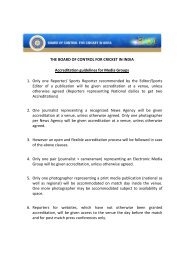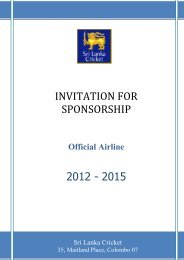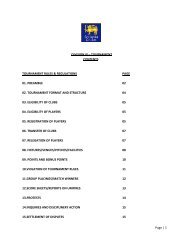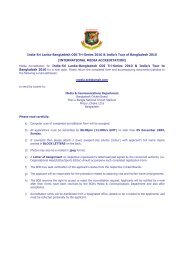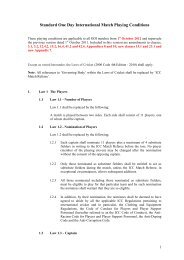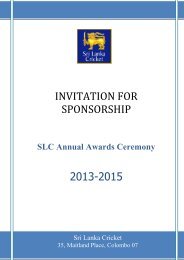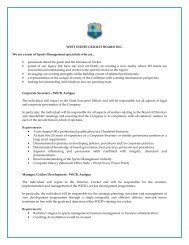Standard ODI Playing Conditions - Sri Lanka Cricket
Standard ODI Playing Conditions - Sri Lanka Cricket
Standard ODI Playing Conditions - Sri Lanka Cricket
Create successful ePaper yourself
Turn your PDF publications into a flip-book with our unique Google optimized e-Paper software.
standard ONE-day INTERNatiONAL<br />
match playing conditions 04<br />
d) in all other circumstances, the two incidents shall be addressed in<br />
chronological order. If the conclusion from the first incident is that<br />
a batsman is dismissed, then the ball would be deemed to have<br />
become dead at that point, rendering investigation of the second<br />
incident unnecessary.<br />
3.9 Interpretation of Laws<br />
a) When using technology to determine where the ball pitched (as per<br />
Law 36.1(b)), the third umpire should refer to the “point” (or centre) of<br />
the ball. Therefore if at least 50% of the ball pitches outside the line<br />
of leg stump, then no LBW dismissal is possible.<br />
b) When using a replay to determine the moment at which the wicket<br />
has been put down (as per Law 28.1), the third umpire should deem<br />
this to be the first frame in which one of the bails is shown (or can<br />
be deduced) to have lost all contact with the top of the stumps and<br />
subsequent frames show the bail permanently removed from the top<br />
of the stumps.<br />
3.10 No Balls<br />
I<br />
Following any mode of dismissal that is not permitted off a no ball and<br />
which is not the subject of an Umpire or Player Review, the third umpire<br />
shall, subject to the availability of suitable technology, immediately check<br />
the fairness of the delivery (foot-fault and bowler breaking the wicket<br />
only). If the delivery was not a fair delivery, the third umpire shall advise<br />
the on-field umpire by two-way radio who should recall the dismissed<br />
batsman, indicate that the batsman is not out and signal no-ball.<br />
if suitable technology is not available to the third umpire, then if the<br />
on-field umpire is uncertain as the fairness of the delivery (foot-fault<br />
and bowler breaking the wicket only), he shall be entitled to request<br />
the batsman to delay leaving the field and to check the fairness of the<br />
delivery (foot-fault and bowler breaking the wicket only) with the third<br />
umpire. Consultation with the third umpire shall be by way of two way<br />
radio. If the delivery was not a fair delivery the on-field umpire shall<br />
indicate that the batsman is not-out and signal no-ball.<br />
3.11 Big Screen Policy<br />
T<br />
the current icc big screen policy will apply.<br />
See also 3.2(d)<br />
4.43



